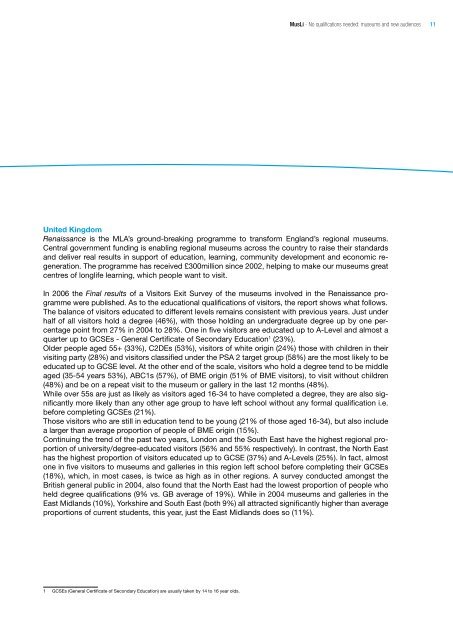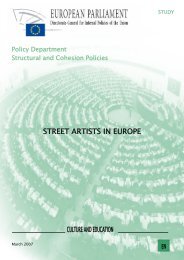MusLi (Museums Literacy) - Fondazione Fitzcarraldo
MusLi (Museums Literacy) - Fondazione Fitzcarraldo
MusLi (Museums Literacy) - Fondazione Fitzcarraldo
You also want an ePaper? Increase the reach of your titles
YUMPU automatically turns print PDFs into web optimized ePapers that Google loves.
<strong>MusLi</strong> - No qualifications needed: museums and new audiences<br />
United Kingdom<br />
Renaissance is the MLA’s ground-breaking programme to transform England’s regional museums.<br />
Central government funding is enabling regional museums across the country to raise their standards<br />
and deliver real results in support of education, learning, community development and economic regeneration.<br />
The programme has received £300million since 2002, helping to make our museums great<br />
centres of longlife learning, which people want to visit.<br />
In 2006 the Final results of a Visitors Exit Survey of the museums involved in the Renaissance programme<br />
were published. As to the educational qualifications of visitors, the report shows what follows.<br />
The balance of visitors educated to different levels remains consistent with previous years. Just under<br />
half of all visitors hold a degree (46%), with those holding an undergraduate degree up by one percentage<br />
point from 27% in 2004 to 28%. One in five visitors are educated up to A-Level and almost a<br />
quarter up to GCSEs - General Certificate of Secondary Education 1 (23%).<br />
Older people aged 55+ (33%), C2DEs (53%), visitors of white origin (24%) those with children in their<br />
visiting party (28%) and visitors classified under the PSA 2 target group (58%) are the most likely to be<br />
educated up to GCSE level. At the other end of the scale, visitors who hold a degree tend to be middle<br />
aged (35-54 years 53%), ABC1s (57%), of BME origin (51% of BME visitors), to visit without children<br />
(48%) and be on a repeat visit to the museum or gallery in the last 12 months (48%).<br />
While over 55s are just as likely as visitors aged 16-34 to have completed a degree, they are also significantly<br />
more likely than any other age group to have left school without any formal qualification i.e.<br />
before completing GCSEs (21%).<br />
Those visitors who are still in education tend to be young (21% of those aged 16-34), but also include<br />
a larger than average proportion of people of BME origin (15%).<br />
Continuing the trend of the past two years, London and the South East have the highest regional proportion<br />
of university/degree-educated visitors (56% and 55% respectively). In contrast, the North East<br />
has the highest proportion of visitors educated up to GCSE (37%) and A-Levels (25%). In fact, almost<br />
one in five visitors to museums and galleries in this region left school before completing their GCSEs<br />
(18%), which, in most cases, is twice as high as in other regions. A survey conducted amongst the<br />
British general public in 2004, also found that the North East had the lowest proportion of people who<br />
held degree qualifications (9% vs. GB average of 19%). While in 2004 museums and galleries in the<br />
East Midlands (10%), Yorkshire and South East (both 9%) all attracted significantly higher than average<br />
proportions of current students, this year, just the East Midlands does so (11%).<br />
1 GCSEs (General Certificate of Secondary Education) are usually taken by 14 to 16 year olds.<br />
11






